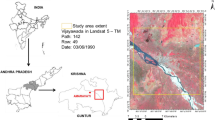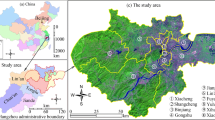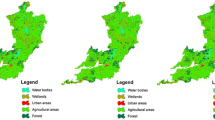Abstract
The world’s coastal regions are experiencing rapid urbanization coupled with increased risk of ecological damage and storm surge related to global climate and sea level rising. This urban development issue is particularly important in China, where many emerging coastal cities are being developed. Lingang New City, southeast of Shanghai, is an excellent example of a coastal city that is increasingly vulnerable to environmental change. Sustainable urban development requires planning that classifies and allocates coastal lands using objective procedures that incorporate changing environmental conditions. In this paper, we applied cellular automata (CA) modeling based on self-adaptive genetic algorithm (SAGA) to predict future scenarios and explore sustainable urban development options for Lingang. The CA model was calibrated using the 2005 initial status, 2015 final status, and a set of spatial variables. We implemented specific ecological and environmental conditions as spatial constraints for the model and predicted four 2030 scenarios: (a) an urban planning-oriented Plan Scenario; (b) an ecosystem protection-oriented Eco Scenario; (c) a storm surge-affected Storm Scenario; and (d) a scenario incorporating both ecosystem protection and the effects of storm surge, called the Ecostorm Scenario. The Plan Scenario has been taken as the baseline, with the Lingang urban area increasing from 45.8 km2 in 2015 to 66.8 km2 in 2030, accounting for 23.9 % of the entire study area. The simulated urban land size of the Plan Scenario in 2030 was taken as the target to accommodate the projected population increase in this city, which was then applied in the remaining three development scenarios. We used CA modeling to reallocate the urban cells to other unconstrained areas in response to changing spatial constraints. Our predictions should be helpful not only in assessing and adjusting the urban planning schemes for Lingang but also for evaluating urban planning in coastal cities elsewhere.






Similar content being viewed by others
References
Akın, A., Sunar, F., & Berberoğlu, S. (2015). Urban change analysis and future growth of Istanbul. Environmental Monitoring and Assessment, 187, 1–15.
Al-Kheder, S., Wang, J., & Shan, J. (2008). Fuzzy inference guided cellular automata urban-growth modelling using multi-temporal satellite images. International Journal of Geographical Information Science, 22, 1271–1293.
Arsanjani, J. J., Helbich, M., Kainz, W., & Boloorani, A. D. (2013). Integration of logistic regression, Markov chain and cellular automata models to simulate urban expansion. International Journal of Applied Earth Observation and Geoinformation, 21, 265–275.
Batty M (2013) The new science of cities: Mit Press.
Batty, M., Xie, Y., & Sun, Z. (1999). Modeling urban dynamics through GIS-based cellular automata. Computers, Environment and Urban Systems, 23, 205–233.
Beyer H-G, Deb K (2001) Self-adaptive genetic algorithms with simulated binary crossover. Universität Dortmund
Bozkaya, A. G., Balcik, F. B., Goksel, C., & Esbah, H. (2015). Forecasting land-cover growth using remotely sensed data: a case study of the Igneada protection area in Turkey. Environmental Monitoring and Assessment, 187, 1–18.
Cao, K., Batty, M., Huang, B., Liu, Y., Yu, L., & Chen, J. (2011). Spatial multi-objective land use optimization: extensions to the non-dominated sorting genetic algorithm-II. International Journal of Geographical Information Science, 25, 1949–1969.
Cao, K., Huang, B., Li, M. C., & Li, W. W. (2014). Calibrating a cellular automata model for understanding rural-urban land conversion: a Pareto front-based multi-objective optimization approach. International Journal of Geographical Information Science, 28, 1028–1046.
Cao M, Tang G, Shen Q, Wang Y (2015) A new discovery of transition rules for cellular automata by using cuckoo search algorithm. International Journal of Geographical Information Science: 1–19.
de Almeida, C. M., Batty, M., Monteiro, A. M. V., Câmara, G., Soares-Filho, B. S., Cerqueira, G. C., & Pennachin, C. L. (2003). Stochastic cellular automata modeling of urban land use dynamics: empirical development and estimation. Computers, Environment and Urban Systems, 27, 481–509.
Desa U (2011) World urbanization prospects, the 2011 revision. New York: United Nations Department of Economic and Social Affairs.
Dezhkam, S., Amiri, B. J., Darvishsefat, A. A., & Sakieh, Y. (2014). Simulating the urban growth dimensions and scenario prediction through sleuth model: a case study of Rasht County, Guilan, Iran. GeoJournal, 79, 591–604.
Eastman J (2009) Idrisi Taiga Manual. Clark Lab Clark University USA.
Feng, Y., & Liu, Y. (2012). An optimised cellular automata model based on adaptive genetic algorithm for urban growth simulation. In Advances in spatial data handling and GIS. Springer.
Feng, Y., & Liu, Y. (2013a). A cellular automata model based on nonlinear kernel principal component analysis for urban growth simulation. Environment and Planning B: Planning and Design, 40, 116–134.
Feng, Y., & Liu, Y. (2013b). A heuristic cellular automata approach for modelling urban land-use change based on simulated annealing. International Journal of Geographical Information Science, 27, 449–466.
Feng, Y., & Liu, Y. (2015). Fractal dimension as an indicator for quantifying the effects of changing spatial scales on landscape metrics. Ecological Indicators, 53, 18–27.
Feng, Y., Liu, Y., & Batty, M. (2016). Modeling urban growth with GIS based cellular automata and least squares SVM rules: a case study in Qingpu–Songjiang area of Shanghai, China. Stochastic Environmental Research and Risk Assessment, 30, 1387–1400.
Feng, Y., Liu, Y., & Liu, D. (2015). Shoreline mapping with cellular automata and the shoreline progradation analysis in shanghai, China from 1979 to 2008. Arabian Journal of Geosciences, 8, 4337–4351.
Feng, Y., Liu, Y., Tong, X., Liu, M., & Deng, S. (2011). Modeling dynamic urban growth using cellular automata and particle swarm optimization rules. Landscape and Urban Planning, 102, 188–196.
Hagoort, M., Geertman, S., & Ottens, H. (2008). Spatial externalities, neighbourhood rules and CA land-use modelling. The Annals of Regional Science, 42, 39–56.
Hanley, J. A., & McNeil, B. J. (1982). The meaning and use of the area under a receiver operating characteristic (ROC) curve. Radiology, 143, 29–36.
He, C., Okada, N., Zhang, Q., Shi, P., & Zhang, J. (2006). Modeling urban expansion scenarios by coupling cellular automata model and system dynamic model in Beijing, China. Applied Geography, 26, 323–345.
Jin, Y. (2014). One city nine ‘ghost’ towns?—seeking an alternative growth model to vitalize the Lingang New Harbor City in Shanghai. TU Delft: Delft University of Technology.
Kim, J. I. (2014). Making cities global: the new city development of Songdo, Yujiapu and Lingang. Planning Perspectives, 29, 329–356.
Lagarias, A. (2015). Exploring land use policy scenarios with the use of a cellular automata-based model: urban sprawl containment and sustainable development in Thessaloniki. Geocarto International, 30, 1033–1051.
Li, L., S-m, L., & Chen, Y. (2010). Better city, better life, but for whom?: the hukou and resident card system and the consequential citizenship stratification in Shanghai. City, Culture and Society, 1, 145–154.
Li, X., & Yeh, A. G.-O. (2002a). Integration of principal components analysis and cellular automata for spatial decisionmaking and urban simulation. Science in China Series D-Earth Sciences, 45, 521–529.
Li, X., & Yeh, A. G.-O. (2002b). Neural-network-based cellular automata for simulating multiple land use changes using GIS. International Journal of Geographical Information Science, 16, 323–343.
Li, X., Lin, J., Chen, Y., Liu, X., & Ai, B. (2013). Calibrating cellular automata based on landscape metrics by using genetic algorithms. International Journal of Geographical Information Science, 27, 594–613.
Li, X., Yang, Q., & Liu, X. (2008). Discovering and evaluating urban signatures for simulating compact development using cellular automata. Landscape and Urban Planning, 86, 177–186.
Li, X., Yang, Q. S., & Liu, X. P. (2007). Genetic algorithms for determining the parameters of cellular automata in urban simulation. Science in China Series D-Earth Sciences, 50, 1857–1866.
Liao, J., Tang, L. N., Shao, G. F., Qiu, Q. Y., Wang, C. P., Zheng, S. N., & Su, X. D. (2014). A neighbor decay cellular automata approach for simulating urban expansion based on particle swarm intelligence. International Journal of Geographical Information Science, 28, 720–738.
Liu, X. P., Li, X., Liu, L., He, J., & Ai, B. (2008a). A bottom-up approach to discover transition rules of cellular automata using ant intelligence. International Journal of Geographical Information Science, 22, 1247–1269.
Liu, X. P., Li, X., Shi, X., Huang, K., & Liu, Y. (2012). A multi-type ant colony optimization (MACO) method for optimal land use allocation in large areas. International Journal of Geographical Information Science, 26, 1325–1343.
Liu, X. P., Li, X., Shi, X., Wu, S., & Liu, T. (2008b). Simulating complex urban development using kernel-based non-linear cellular automata. Ecological Modelling, 211, 169–181.
Liu, X. P., Li, X., Shi, X., Zhang, X., & Chen, Y. (2010). Simulating land-use dynamics under planning policies by integrating artificial immune systems with cellular automata. International Journal of Geographical Information Science, 24, 783–802.
Liu, X. P., Ma, L., Li, X., Ai, B., Li, S. Y., & He, Z. J. (2014a). Simulating urban growth by integrating landscape expansion index (LEI) and cellular automata. International Journal of Geographical Information Science, 28, 148–163.
Liu, Y. (2012). Modelling sustainable urban growth in a rapidly urbanising region using a fuzzy-constrained cellular automata approach. International Journal of Geographical Information Science, 26, 151–167.
Liu, Y., & Feng, Y. (2012). A logistic based cellular automata model for continuous urban growth simulation: a case study of the Gold Coast City, Australia. Agent-based Models of Geographical Systems: Springer.
Liu, Y., & Phinn, S. R. (2003). Modelling urban development with cellular automata incorporating fuzzy-set approaches. Computers, Environment and Urban Systems, 27, 637–658.
Liu, Y., Feng, Y., & Pontius, R. G. (2014b). Spatially-explicit simulation of urban growth through self-adaptive genetic algorithm and cellular automata modelling. Land, 3, 719–738.
Liu, Y. L., Tang, W., He, J., Liu, Y., Ai, T., & Liu, D. (2015). A land-use spatial optimization model based on genetic optimization and game theory. Computers, Environment and Urban Systems, 49, 1–14.
Ma, F., & Cai, Y. L. (2013). Impacts on the land use and ecosystem services value in Shanghai Lingang New City exploitation. Journal of Fudan University: Natural Science, 1, 69–77.
McGarigal K (2014) Fragstats v4: Spatial Pattern Analysis Program for Categorical and Continuous Maps-Help manual. Amherst: University of Massachusetts Recuperado de http://www.umassedu/landeco/research/fragstats/fragstats.html.
McGranahan, G., Balk, D., & Anderson, B. (2007). The rising tide: assessing the risks of climate change and human settlements in low elevation coastal zones. Environment and Urbanization, 19, 17–37.
Mills M, Leon JX, Saunders MI, Bell J, Liu Y, O’Mara J, Lovelock CE, Mumby PJ, Phinn S, Possingham HP (2015) Reconciling Development and Conservation under Coastal Squeeze from Rising Sea Level. Conservation Letters.
Moghadam, H. S., & Helbich, M. (2013). Spatiotemporal urbanization processes in the megacity of Mumbai, India: a Markov chains-cellular automata urban growth model. Applied Geography, 40, 140–149.
Mu, B., Mayer, A. L., He, R., & Tian, G. (2016). Land use dynamics and policy implications in Central China: a case study of Zhengzhou. Cities, 58, 39–49.
Nicholls, R. J., Hanson, S., Herweijer, C., Patmore, N., Hallegatte, S., Corfee-Morlot, J., Château, J., & Muir-Wood, R. (2008). Ranking port cities with high exposure and vulnerability to climate extremes. OECD Environment Working Papers DOI. doi:10.1787/19970900.
Peterson, G. D., Cumming, G. S., & Carpenter, S. R. (2003). Scenario planning: a tool for conservation in an uncertain world. Conservation Biology, 17, 358–366.
Pontius, R. G. (2000). Quantification error versus location error in comparison of categorical maps. Photogrammetric Engineering and Remote Sensing, 66, 1011–1016.
Pontius, R. G., & Millones, M. (2011). Death to kappa: birth of quantity disagreement and allocation disagreement for accuracy assessment. International Journal of Remote Sensing, 32, 4407–4429.
Pontius, R. G., & Schneider, L. C. (2001). Land-cover change model validation by an ROC method for the Ipswich watershed, Massachusetts, USA. Agriculture, Ecosystems & Environment, 85, 239–248.
Qiang, Y., & Lam, N. S. (2015). Modeling land use and land cover changes in a vulnerable coastal region using artificial neural networks and cellular automata. Environmental Monitoring and Assessment, 187, 1–16.
Riccioli, F., El Asmar, T., El Asmar, J.-P., Fagarazzi, C., & Casini, L. (2016). Artificial neural network for multifunctional areas. Environmental Monitoring and Assessment, 188, 1–11.
Riccioli, F., El Asmar, T., El Asmar, J.-P., & Fratini, R. (2013). Use of cellular automata in the study of variables involved in land use changes. Environmental Monitoring and Assessment, 185, 5361–5374.
Ringland, G., & Schwartz, P. P. (1998). Scenario planning: managing for the future. John Wiley & Sons.
Sakieh, Y., & Salmanmahiny, A. (2016). Performance assessment of geospatial simulation models of land-use change—a landscape metric-based approach. Environmental Monitoring and Assessment, 188, 1–16.
Sakieh, Y., Amiri, B. J., Danekar, A., Feghhi, J., & Dezhkam, S. (2015). Scenario-based evaluation of urban development sustainability: an integrative modeling approach to compromise between urbanization suitability index and landscape pattern. Environment, Development and Sustainability, 17, 1343–1365.
Santé, I., García, A. M., Miranda, D., & Crecente, R. (2010). Cellular automata models for the simulation of real-world urban processes: a review and analysis. Landscape and Urban Planning, 96, 108–122.
Shan, J., Alkheder, S., & Wang, J. (2008). Genetic algorithms for the calibration of cellular automata urban growth modeling. Photogrammetric Engineering & Remote Sensing, 74, 1267–1277.
Shao, Z. (2015). China has stepped into the new urban area age. The New Urban Area Development: Springer.
Shi Y, Chen Y (2015) New city planning and construction in Shanghai: retrospective and prospective. International Journal of Urban Sciences: 1–24.
Song, B. L. (2009). Development strategy of Lingang New City’s industrial clusters in Shanghai. Journal of Shanghai Maritime University, 1, 10–13.
Song, S. (2014). Ship emissions inventory, social cost and eco-efficiency in Shanghai Yangshan port. Atmospheric Environment, 82, 288–297.
Stevens, D., Dragicevic, S., & Rothley, K. (2007). iCity: a GIS–CA modelling tool for urban planning and decision making. Environmental Modelling & Software, 22, 761–773.
Storch, H., & Downes, N. K. (2011). A scenario-based approach to assess Ho Chi Minh City’s urban development strategies against the impact of climate change. Cities, 28, 517–526.
Thia-Eng, C. (1993). Essential elements of integrated coastal zone management. Ocean & Coastal Management, 21, 81–108.
van de Heijden, K. (1996). Scenarios: the art of strategic conservation. Chichester, New York: John Wiley & Sons.
Van Niel, K. P., & Laffan, S. W. (2011). There is no good excuse for a bad random number generator: a reply to Barry. International Journal of Geographical Information Science, 25, 531–539.
Wang, C., & Ducruet, C. (2012). New port development and global city making: emergence of the Shanghai–Yangshan multilayered gateway hub. Journal of Transport Geography, 25, 58–69.
White, R., Straatman, B., & Engelen, G. (2004). Planning scenario visualization and assessment: a cellular automata based integrated spatial decision support system. Spatially integrated social science, 420.
Wu, F. (1998). SimLand: a prototype to simulate land conversion through the integrated GIS and CA with AHP-derived transition rules. International Journal of Geographical Information Science, 12, 63–82.
Wu, F., & Webster, C. J. (1998). Simulation of land development through the integration of cellular automata and multicriteria evaluation. Environment and Planning B: Planning and Design, 25, 103–126.
Xu, H., Chen, L., Zhao, B., Zhang, Q., & Cai, Y. (2015). Green stormwater infrastructure eco-planning and development on the regional scale: a case study of Shanghai Lingang New City, East China. Frontiers of Earth Science, 1–12.
Yang, Q., Li, X., & Shi, X. (2008). Cellular automata for simulating land use changes based on support vector machines. Computers & Geosciences, 34, 592–602.
Ying, X., Ding, P., Wang, Z. B., & Van Maren, D. S. (2011). Morphological impact of the construction of an offshore Yangshan Deepwater Harbor in the port of Shanghai, China. Journal of Coastal Research, 28, 163–173.
Zhang, H., Zeng, Y., & Bian, L. (2010). Simulating multi-objective spatial optimization allocation of land use based on the integration of multi-agent system and genetic algorithm. International Journal of Environmental Research, 4, 765–776.
Acknowledgments
This study is supported by the National Natural Science Foundation of China (Project 41406146), the Natural Science Foundation of Shanghai Municipality (Project 13ZR1419300), and Shanghai Universities First-class Disciplines Project-Fisheries (A).
Author information
Authors and Affiliations
Corresponding author
Ethics declarations
All procedures performed in studies involving human participants were in accordance with the ethical standards of the institutional and/or national research committee and with the 1964 Helsinki declaration and its later amendments or comparable ethical standards. This article does not contain any studies with animals performed by any of the authors. Informed consent was obtained from all individual participants included in the study.
Conflict of interest
The authors declare that they have no conflict of interest.
Rights and permissions
About this article
Cite this article
Feng, Y., Liu, Y. Scenario prediction of emerging coastal city using CA modeling under different environmental conditions: a case study of Lingang New City, China. Environ Monit Assess 188, 540 (2016). https://doi.org/10.1007/s10661-016-5558-y
Received:
Accepted:
Published:
DOI: https://doi.org/10.1007/s10661-016-5558-y




